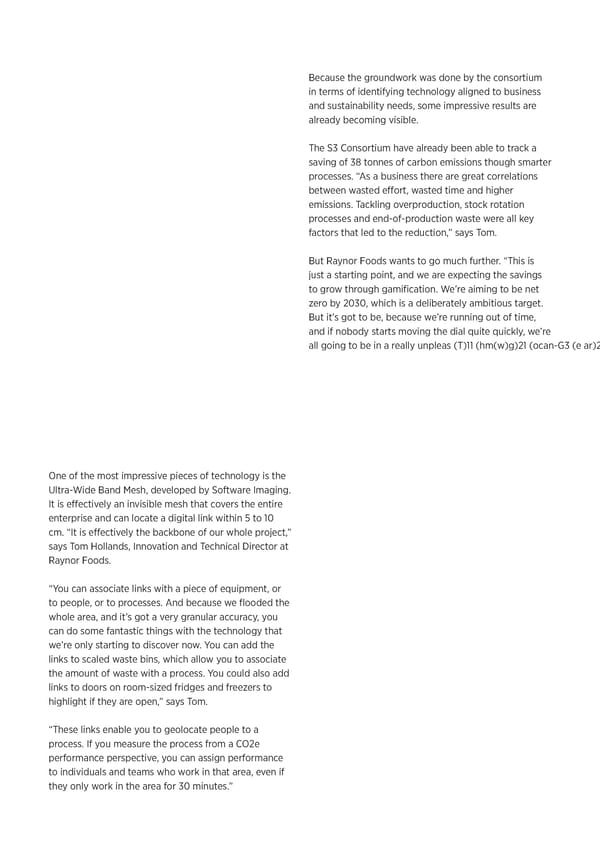SUSTAINABILITY SPOTLIGHT | 17 Because the groundwork was done by the consortium in terms of identifying technology aligned to business and sustainability needs, some impressive results are already becoming visible. The S3 Consortium have already been able to track a saving of 38 tonnes of carbon emissions though smarter processes. “As a business there are great correlations between wasted e昀昀ort, wasted time and higher emissions. Tackling overproduction, stock rotation processes and end-of-production waste were all key factors that led to the reduction,” says Tom. But Raynor Foods wants to go much further. “This is just a starting point, and we are expecting the savings to grow through gami昀椀cation. We’re aiming to be net zero by 2030, which is a deliberately ambitious target. But it’s got to be, because we’re running out of time, and if nobody starts moving the dial quite quickly, we’re all going to be in a really unpleasant place,” says Tom. Smart people and gami昀椀cation The company knew that the only way to do this was to get the entire workforce on board. “Because it’s only through an engaged workforce that we’re going to deliver these things. We want to make sustainability more relevant and personal to them. One area we hope to move the needle on is making the invisible – things One of the most impressive pieces of technology is the like CO2 emissions – visible, to motivate sta昀昀 to 昀椀nd Ultra-Wide Band Mesh, developed by Software Imaging. ways to reduce waste they can’t necessarily see,” says It is e昀昀ectively an invisible mesh that covers the entire Tom. enterprise and can locate a digital link within 5 to 10 cm. “It is e昀昀ectively the backbone of our whole project,” With the data in hand and an awareness of the changes says Tom Hollands, Innovation and Technical Director at that needed to be made, the challenge was to convey Raynor Foods. this information to the workforce in a way that would engage them on a personal level, and to encourage the “You can associate links with a piece of equipment, or behaviours and values that Raynor Foods want to live to people, or to processes. And because we 昀氀ooded the by as an organisation. whole area, and it’s got a very granular accuracy, you can do some fantastic things with the technology that To this end, they approached the IfM, part of the we’re only starting to discover now. You can add the University of Cambridge, which has been leading the links to scaled waste bins, which allow you to associate development of a gami昀椀cation programme to make the amount of waste with a process. You could also add improvements in sustainability. The system, which links to doors on room-sized fridges and freezers to allows employees to earn points that transform into a highlight if they are open,” says Tom. variety of rewards and bene昀椀ts, is the most advanced and innovative such system in the food industry. “These links enable you to geolocate people to a process. If you measure the process from a CO2e “It’s an engagement and education tool that allows performance perspective, you can assign performance us to motivate and achieve behavioural change, while to individuals and teams who work in that area, even if making the work fun and valuable for the employees” they only work in the area for 30 minutes.” explains Ergün Güngör, Research Associate at the IfM.
 Sustainability Spotlight Magazine Page 16 Page 18
Sustainability Spotlight Magazine Page 16 Page 18